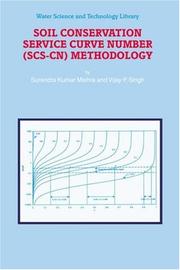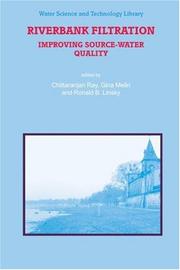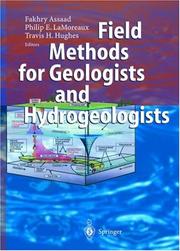| Listing 1 - 6 of 6 |
Sort by
|
Book
Year: 2003 Publisher: Sacramento, CA : [Denver, CO] : U.S. Dept. of the Interior, U.S. Geological Survey ; [U.S. Geological Survey, Information Services,distributor],
Abstract | Keywords | Export | Availability | Bookmark
 Loading...
Loading...Choose an application
- Reference Manager
- EndNote
- RefWorks (Direct export to RefWorks)
Book
Year: 2003 Publisher: Denver, Colo. : U.S. Dept. of the Interior, U.S. Geological Survey,
Abstract | Keywords | Export | Availability | Bookmark
 Loading...
Loading...Choose an application
- Reference Manager
- EndNote
- RefWorks (Direct export to RefWorks)
Organic water pollutants --- Trace elements in water --- River sediments
Book
ISBN: 1280011416 9786610011414 9240686789 Year: 2003 Publisher: Geneva : World Health Organization,
Abstract | Keywords | Export | Availability | Bookmark
 Loading...
Loading...Choose an application
- Reference Manager
- EndNote
- RefWorks (Direct export to RefWorks)
This book evaluates the effects of silver and silver comounds to the environment including their uptake and accumulation in plants. Silver is a rare but naturally occurring metal often found deposited as a mineral ore in association with other elements. Emissions from smelting operations manufacture and disposal of certain photographic and electrical supplies coal combustion and cloud seeding are some of the anthropogenic sources of silver and silver compounds in the biosphere.
Environmental Exposure. --- Risk Assessment. --- Silver -- adverse effects. --- Silver -- Environmental aspects. --- Silver Compounds -- adverse effects. --- Silver compounds -- Environmental aspects. --- Water Pollutants, Chemical -- adverse effects. --- Silver. --- Silver Compounds. --- Risk Assessment. --- Water Pollutants, Chemical. --- Environmental Exposure. --- Risk. --- Environmental Pollution. --- Water Pollutants. --- Epidemiologic Measurements. --- Metals, Heavy. --- Inorganic Chemicals. --- Transition Elements. --- Risk Management. --- Probability. --- Public Health. --- Environmental Pollutants. --- Elements. --- Chemicals and Drugs --- Metals. --- Organization and Administration. --- Environment and Public Health. --- Health Services Administration. --- Statistics as Topic. --- Toxic Actions. --- Delivery of Health Care. --- Chemical Actions and Uses. --- Epidemiologic Methods. --- Health Care Evaluation Mechanisms. --- Quality of Health Care. --- Investigative Techniques. --- Analytical, Diagnostic and Therapeutic Techniques and Equipment --- Health Care Quality, Access, and Evaluation.

ISBN: 1402011326 9048162254 9401701474 9781402011320 Year: 2003 Volume: 42 Publisher: Dordrecht: Kluwer Academic Publishers,
Abstract | Keywords | Export | Availability | Bookmark
 Loading...
Loading...Choose an application
- Reference Manager
- EndNote
- RefWorks (Direct export to RefWorks)
The Soil Conservation Service (SCS) curve number (CN) method is one of the most popular methods for computing the runoff volume from a rainstorm. It is popular because it is simple, easy to understand and apply, and stable, and accounts for most of the runoff producing watershed characteristics, such as soil type, land use, hydrologic condition, and antecedent moisture condition. The SCS-CN method was originally developed for its use on small agricultural watersheds and has since been extended and applied to rural, forest and urban watersheds. Since the inception of the method, it has been applied to a wide range of environments. In recent years, the method has received much attention in the hydrologic literature. The SCS-CN method was first published in 1956 in Section-4 of the National Engineering Handbook of Soil Conservation Service (now called the Natural Resources Conservation Service), U. S. Department of Agriculture. The publication has since been revised several times. However, the contents of the methodology have been nonetheless more or less the same. Being an agency methodology, the method has not passed through the process of a peer review and is, in general, accepted in the form it exists. Despite several limitations of the method and even questionable credibility at times, it has been in continuous use for the simple reason that it works fairly well at the field level.
Runoff --- Rain and rainfall --- Mathematical models. --- Hydrogeology. --- Agriculture. --- Water pollution. --- Waste Water Technology / Water Pollution Control / Water Management / Aquatic Pollution. --- Aquatic pollution --- Fresh water --- Fresh water pollution --- Freshwater pollution --- Inland water pollution --- Lake pollution --- Lakes --- Reservoirs --- River pollution --- Rivers --- Stream pollution --- Water contamination --- Water pollutants --- Water pollution --- Pollution --- Waste disposal in rivers, lakes, etc. --- Farming --- Husbandry --- Industrial arts --- Life sciences --- Food supply --- Land use, Rural --- Geohydrology --- Geology --- Hydrology --- Groundwater --- Runoff - Mathematical models. --- Rain and rainfall - Mathematical models.

ISBN: 0306481545 1402011334 Year: 2003 Publisher: Dordrecht : Springer Netherlands,
Abstract | Keywords | Export | Availability | Bookmark
 Loading...
Loading...Choose an application
- Reference Manager
- EndNote
- RefWorks (Direct export to RefWorks)
Chittaranjan Ray, Ph. D. , P. E. University of Hawaii at Mãnoa Honolulu, Hawaii, United States Jürgen Schubert, M. Sc. Stadtwerke Düsseldorf AG Düsseldorf, Germany Ronald B. Linsky National Water Research Institute Fountain Valley, California, United States Gina Melin National Water Research Institute Fountain Valley, California, United States 1. What is Riverbank Filtration? The purpose ofthis book is to show that riverbank filtration (RBF) isa low-cost and efficient alternative water treatment for drinking-water applications. There are two immediate benefits to the increased use of RBF: Minimized need for adding chemicals like disinfectants and coagulants to surface water to control pathogens. Decreased costs to the community without increased risk to human health. Butwhat,exactly, isRBF? In humid regions, river water naturally percolates through the ground into aquifers (which are layers of sand and gravel that contain water underground) during high-flow conditions. In arid regions, most rivers lose flow, and the percolating water passes through soil and aquifer material until it reaches the water table. During these percolation processes, potential contaminants present in river water are filtered and attenuated. If there are no other contaminants present in the aquifer or ifthe respective contaminants are present at lower concentrations, the quality of water in the aquifer can be ofhigher quality than that found in theriver. In RBF, production wells — which are placed near the banks ofrivers —pump large quantities ofwater.
Environment. --- Geochemistry. --- Hydrogeology. --- Air pollution. --- Water pollution. --- Waste Water Technology / Water Pollution Control / Water Management / Aquatic Pollution. --- Atmospheric Protection/Air Quality Control/Air Pollution. --- Water --- Purification --- Riverbank filtration. --- Aquatic pollution --- Fresh water --- Fresh water pollution --- Freshwater pollution --- Inland water pollution --- Lake pollution --- Lakes --- Reservoirs --- River pollution --- Rivers --- Stream pollution --- Water contamination --- Water pollutants --- Water pollution --- Pollution --- Waste disposal in rivers, lakes, etc. --- Air --- Air contaminants --- Air pollutants --- Air pollution --- Air pollution control --- Air toxics --- Airborne pollutants --- Atmosphere --- Contaminants, Air --- Control of air pollution --- Pollutants, Air --- Toxics, Air --- Air quality --- Atmospheric deposition --- Geohydrology --- Geology --- Hydrology --- Groundwater --- Chemical composition of the earth --- Chemical geology --- Geological chemistry --- Geology, Chemical --- Chemistry --- Earth sciences --- Riverbank filtration --- Riverbank infiltration --- Control --- Filtration --- Pollution.

ISBN: 3540408827 366205440X 3662054388 Year: 2003 Publisher: Berlin : Springer,
Abstract | Keywords | Export | Availability | Bookmark
 Loading...
Loading...Choose an application
- Reference Manager
- EndNote
- RefWorks (Direct export to RefWorks)
The authors describe project performance, methods for field study of rocks, soils, and outcrops and how to evaluate impacts of air pollution and water resources systems. Furthermore, they develop guidelines for graphic and text presentation of results of studies and describe superficial rock characteristics and subsurface geological mapping techniques. The text covers hydrogeologic methods, groundwater monitoring systems, contamination and waste management and discusses groundwater flow in fractured and granular aquifers, including a special reference to karstic aquifers. In addition to this, international waste management rules and regulations are listed. A glossary is provided of geological and hydrogeological terms, as well as a standard terminology for soils, rocks, and contained fluids.
Geology --- Hydrogeology --- Fieldwork. --- Fieldwork --- 550.8.04 --- 550.8.04 Observations. Geophysical field survey --- Observations. Geophysical field survey --- Geology. --- Geotechnical engineering. --- Geoecology. --- Environmental geology. --- Nature conservation. --- Regional planning. --- Urban planning. --- Water pollution. --- Geotechnical Engineering & Applied Earth Sciences. --- Geoecology/Natural Processes. --- Nature Conservation. --- Landscape/Regional and Urban Planning. --- Waste Water Technology / Water Pollution Control / Water Management / Aquatic Pollution. --- Aquatic pollution --- Fresh water --- Fresh water pollution --- Freshwater pollution --- Inland water pollution --- Lake pollution --- Lakes --- Reservoirs --- River pollution --- Rivers --- Stream pollution --- Water contamination --- Water pollutants --- Water pollution --- Pollution --- Waste disposal in rivers, lakes, etc. --- Cities and towns --- City planning --- Civic planning --- Land use, Urban --- Model cities --- Redevelopment, Urban --- Slum clearance --- Town planning --- Urban design --- Urban development --- Urban planning --- Land use --- Planning --- Art, Municipal --- Civic improvement --- Regional planning --- Urban policy --- Urban renewal --- Regional development --- State planning --- Human settlements --- Landscape protection --- Conservation of nature --- Nature --- Nature protection --- Protection of nature --- Conservation of natural resources --- Applied ecology --- Conservation biology --- Endangered ecosystems --- Natural areas --- Geoecology --- Environmental protection --- Physical geology --- Engineering, Geotechnical --- Geotechnics --- Geotechnology --- Engineering geology --- Geognosy --- Geoscience --- Earth sciences --- Natural history --- Government policy --- Management --- Conservation
| Listing 1 - 6 of 6 |
Sort by
|

 Search
Search Feedback
Feedback About UniCat
About UniCat  Help
Help News
News